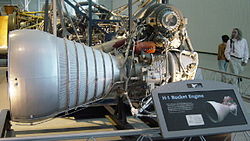Rocketdyne H-1

Rocketdyne's H-1 is a 205,000 lbf (910 kN) thrust liquid fuel rocket engine burning LOX and RP-1. The H-1 was developed for use in the S-IB first stage of the Saturn I and Saturn IB rockets, where it was used in clusters of eight engines. This was the H-1's only use.
History
When Heinz-Hermann Koelle first drew up plans for what would become the Saturn, he selected Rocketdyne's E-1 to power it, with four engines in the lower stage. Rocketdyne was developing this 400,000 lbf engine for the Titan missile, and it was the largest engine available in the time frame that ARPA gave Werner von Braun to develop what was then known as the "Juno V". In 1957, after the launch of Sputnik 1, the U.S. quickly developed plans to start a civilian space agency, which quickly developed into NASA. As the Army had lost interest in large rockets, they agreed to turn over von Braun's ABMA team to NASA, becoming the Marshall Space Flight Center. The handover would take place in 1960.
Shortly after these plans were made, ARPA visited ABMA and told von Braun that they still had $10 million in their budget to spend before the handover. They asked if there was anything they could do before the handover that could effectively use the money. von Braun called in Koelle and showed them a model of the Juno V, but the ARPA visitors noted that the E-1 engine wouldn't be ready by 1960. Brainstorming, they decided that the best approach was to make a minor upgrade to Rocketdyne's existing 175,000 lbf engines to boost them to 200,000 lbf, and use eight of these new engines instead of four E-1s. A contract for development was soon tendered, and by the end of 1958 the name changed from Juno to Saturn, meaning "the planet after Jupiter", the Jupiter missile being the previous ABMA design. Rocketdyne had several engine designs in the pipeline at that point, the E-1, the F-1 being developed for the US Air Force, and a proposal for a flourine-burning G-1 - the new design became the H-1.
Description
Like all of Rocketdyne's early engines, the H-1 used a waterfall injector fed by turbopumps, and regeneratively cooled the engine with the liquid oxygen.
Unlike the J-2 engine used on the S-IVB stage, the H-1 was a single-start engine. It could be fired multiple times—and engines were usually subject to two or more static test firings before a mission to flight-qualify them—but it could not be restarted in flight, because some components required for the startup sequence were non-reusable. In particular, the engine was ignited by a Solid Propellant Gas Generator (SPGG), which was essentially a small solid rocket, and had to be replaced after each firing.
To start the engine a 500V AC voltage was applied to the SPGG, which ignited the solid propellant. This produced hot gas which was allowed to build up until reaching a pressure of 600-700 psi, after which a bursting diaphragm released it into the turbine which drove the fuel turbopumps. This began the process of pumping fuel and oxidiser into the engine, and the hot gases from the SPGG provided the initial energy required to ignite the fuel/oxidizer mix. Once the fuel and oxidizer were being pumped and burning, the process was self-sustaining until engine shutdown.
Specifications
| Vehicle effectivity | ||
|---|---|---|
| SA-201 through SA-205 | SA-206 and subsequent | |
| Thrust (sea level) | 200,000 lbf (890 kN) | 205,000 lbf (910 kN) |
| Thrust duration | 155 s | 155 s |
| Specific impulse | 289 s | 289 s |
| Engine weight dry (inboard) | 1,830 pounds (830 kg) | 2,200 pounds (1,000 kg) |
| Engine weight dry (outboard) | 2,100 pounds (950 kg) | 2,100 pounds (950 kg) |
| Engine weight burnout | 2,200 pounds (1,000 kg) | 2,200 pounds (1,000 kg) |
| Exit-to-throat area ratio | 8:1 | 8:1 |
| Propellants | LOX & RP-1 | LOX & RP-1 |
| Mixture ratio | 2.23±2% | 2.23±2% |
| Fuel flow rate | 2092 USgal/min (132 L/s) | |
| Oxidizer flow rate | 3330 USgal/min (210 L/s) | |
| Nominal chamber pressure | 633 psi (4.36 MPa) | |
- Contractor: NAA/Rocketdyne
- Vehicle Application: Saturn I / S-I 1st stage - 8 engines
- Vehicle Application: Saturn IB / S-IB 1st stage - 8 engines
References
Skylab Saturn IB Flight Manual, 30 September 1972
